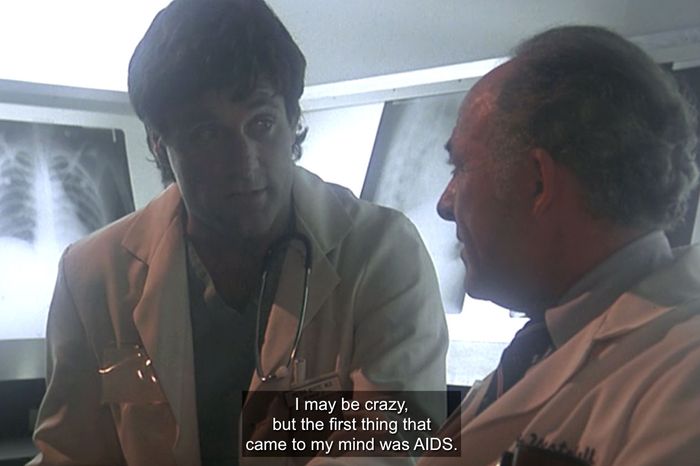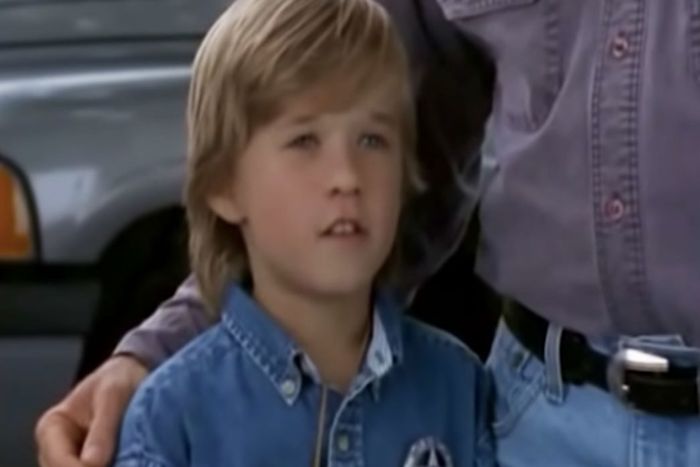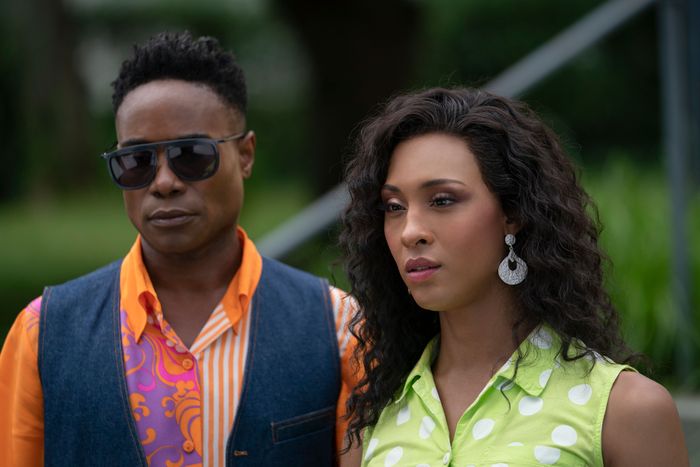
It is not an exaggeration to say that television has played an integral part in how many of us came to understand what the letters HIV and AIDS stand for. From medical dramas and procedurals to cable movies and period pieces, American television has as easily reflected as reshaped public opinion on these issues, one fictional character at a time.
While unscripted television has broken major ground in this regard ÔÇö see the impact of The Real World, Project Runway, and RuPaulÔÇÖs Drag Race, to name but a few ÔÇö the following history, brief and protracted as it may be, deals exclusively with scripted fare. It offers a glimpse into the way television creators have used the tools of serialized storytelling and the powers of network distribution to grapple with one of the defining crises of the last half century. Take a journey with us through close to 40 yearsÔÇÖ worth of TV stories about HIV and AIDS.
The 1980s: Victims & Villains
ItÔÇÖs no surprise that AIDS first appeared on prime-time television in a hospital drama. The genre, then being revolutionized by NBCÔÇÖs St. Elsewhere, was tailor-made to deal with story lines about the misconceptions about HIV and AIDS. In a December 1983 episode titled ÔÇ£AIDS and Comfort,ÔÇØ the staff at the fictional St. Eligius Hospital saw how fear and shame operated when treating a patient diagnosed with AIDS. A married rising political star, the patient earns the interest of the press and threatens the success of the hospitalÔÇÖs blood drive (one staff member refuses to go anywhere near a needle until ÔÇ£Mr. AIDSÔÇØ is out of the building). In many ways, that second season St. Elsewhere episode remains a template for how shows like E.R., House M.D., and GreyÔÇÖs Anatomy have gone on to tackle HIV and AIDS story lines in the decades since, using medical professionals as gateways to inform and educate a mainstream audience.
In keeping with St. ElsewhereÔÇÖs warmly compassionate sensibility, viewers were treated to a closing scene that addressed its audience as much as it did its more judgmental characters: ÔÇ£Why should any of us be penalized for choosing a certain lifestyle?ÔÇØ Ed FlandersÔÇÖs Dr. Donald Westphall says, addressing a colleague whoÔÇÖd suggested the patient shouldÔÇÖve been more careful about his womanizing. ÔÇ£IÔÇÖll tell you something, I donÔÇÖt give a damn about all this talk about morality and vengeful gods and all that. If you have AIDS, youÔÇÖre sick, you need help. And thatÔÇÖs all that matters. And thatÔÇÖs why weÔÇÖre here.ÔÇØ Such a message was characteristic of many of the early depictions of AIDS patients on scripted TV, a call for compassion that went hand in hand with a push to dispel misinformation about the virus.
But the fact that this first appearance concerned itself with a white, heterosexual, well-off character whoÔÇÖs depicted as the victim of an ill-timed affair was not coincidental. With a desire to change minds and to push back against weaponized stereotypes about drug users and homosexual men, television writers struggled with how to tell authentic stories that fit the kinds of worlds its popular sitcoms and dramas were so squarely representing.
Television movies and serialized dramas, by the nature of their narrative structure, relied heavily on one-off stories about characters that were here today and gone tomorrow. Thus, even when a production like NBCÔÇÖs An Early Frost, the very first made-for-TV movie to focus on AIDS, broke new ground when it aired back in November 1985, it also revealed the challenges and limitations of such mainstream fare. The film starred Aidan Quinn as Michael Pierson, a lawyer who returns home to tell his parents that he has AIDS. Ahead of its premiere, a New York Times article outlined how meticulously vetted its screenplay was by the network, all the while explaining how the production tiptoed around the then-ÔÇ£controversialÔÇØ aspect of MichaelÔÇÖs sexuality: ÔÇ£We wanted to make an honest drama without a political point of view,ÔÇØ NBCÔÇÖs senior vice-president in charge of programming Steve White told the Times. ÔÇ£Although we show that Michael has a life as a gay man, the more important issues are what happens within his family.ÔÇØ
That same year, Dan Rather informed his viewers that AIDS was not at all what people first thought, a mysterious killer that seemed to strike beyond the bounds of respectable society  something you caught in alleyways from a dirty needle or picked up in gay haunts doing things most people dont do. Instead, it was a deadly virus that makes no moral or sexual distinctions. And its making its way very slowly toward Main Street.
Broadcast networks were soon bringing more stories about ÔÇ£AIDS on Main StreetÔÇØ to viewers everywhere. CBS aired 1988ÔÇÖs Go Toward the Light (starring Linda Hamilton) about a young boy diagnosed with AIDS, while ABC aired The Ryan White Story (about a hemophiliac boy afflicted with AIDS) in 1989. Those summaries alone signal the kinds of films being targeted toward broadcast TV audiences: those whose plots insisted on the centrality of ÔÇ£familyÔÇØ as the way to understand the effect of the virus. Even when its protagonists were gay men (like in HBOÔÇÖs 1988 film Tidy Endings, or 1997ÔÇÖs In the Gloaming, and even ABCÔÇÖs 1991 film starring Julie Andrews, Our Sons), the epidemic was often reduced to a domestic concern that could best be understood in terms of a mother losing a child.
The move toward making AIDS dramas exist within these domestic spaces, and away from larger political musings, was in many ways strategic. Once you stopped thinking in terms of statistics and focused on one dying young man whose family and loved ones youÔÇÖd gotten to know and could identify with, it became increasingly hard to give in to the hateful, dehumanizing rhetoric that characterized right-wing conservatives under the Reagan administration.
Not that television wasnÔÇÖt also fueling those fears. In 1988, a planned episode of NBCÔÇÖs Midnight Caller earned the ire of activists in San Francisco who opposed its depiction of a bisexual man who was, in the episodeÔÇÖs parlance, going around knowingly infecting people with the virus. The protests eventually pressured the network to do some rewrites, but even with revisions, ÔÇ£After It HappenedÔÇØ remains an example of the way those living with the virus were often depicted as being culpable ÔÇö either for contracting it or for further spreading it. In tandem, shows like The Equalizer, 21 Jump Street, and Leg Work dealt with story lines that openly interrogated the culpability of those afflicted, even as they still created an us-versus-them mentality when dealing with those living with and dying from the virus.
The 1990s: The Very Special Episodes
By the end of the 1980s, the didactic potential of television had become a key way for the general public to learn about HIV and AIDS, especially as public advocacy and awareness continued to grow following the death of icons like Rock Hudson and Liberace. Shows like Mr. Belvedere, Designing Women, The Golden Girls, and Doogie Howser, M.D. all famously featured episodes where its main cast of characters came in close contact with someone who had been recently diagnosed and/or was about to die from AIDS complications, a template that would be repeated under various guises in shows as disparate as A Different World, thirtysomething, Melrose Place, Walker, Texas Ranger (guest-starring Haley Joel Osment, no less), and Captain Planet and the Planeteers. These were all welcome steps forward, even as they continued to center the experience of straight characters whose contact with the virus was but a catalyst to unpack their own prejudices and bigotry, often also addressing the homophobic rhetoric around the disease itself.
But there remained the implicit admission that only certain stories could make it to air. Reviewing Something to Live for: The Alison Gertz Story for New York Magazine, for instance, TV critic John Leonard articulated the reason the tale of Gertz, who became an AIDS activist in the late 1980s, so resonated. Alison, he writes, is ÔÇ£young, gifted, white, female, cute, equally innocent of leather bars and IV drugs, upper-middle class, and Upper East Side. Such unfairness ought never to have happened to such a sweetheart.ÔÇØ The tacit implication was, of course, that there were people for whom such a fate wasnÔÇÖt so unfair. But itÔÇÖs his other word ÔÇö ÔÇ£innocentÔÇØ ÔÇö which captures what characterized much of the approach to telling stories about those living with AIDS. Who was deemed innocent? Who was deemed worthy of our compassion? Of our understanding? In the cultural American imagination, such questions yielded very narrow answers even as projects like Something to Live For were openly trying to bridge a divide and offering powerful testimonials about a still-raging epidemic.
Take ABCÔÇÖs Rock Hudson film from 1990. Framed by the Marc Christian trial ÔÇö HudsonÔÇÖs former lover who sued the actorÔÇÖs estate, arguing that Hudson had continued to have sex with him even after learning of his own AIDS diagnosis ÔÇö the made-for-TV film couldnÔÇÖt help but lean into the lurid tales following the iconic starÔÇÖs death. Boycotted by advertisers, the project served as a reminder of how controversial even such a salacious treatment of homosexuality and AIDS could still be on prime-time television. Even a project like HBOÔÇÖs And the Band Played On, which finally aired in 1993 after a protracted development period, did away with much of Randy ShiltsÔÇÖs nonfiction book on the early years of the epidemic, and became, in turn, a medical thriller centered on a straight doctor (played by Matthew Modine) that relegated many of the LGBTQ figures Shilts profiled to supporting characters.
The crux of the problem lay in the way stories about AIDS remained inseparable from stories about homosexual characters even as, by 1994, AIDS had become the leading cause of death for all Americans ages 25 to 44. By the time Beverly Hills: 90210 did a multi-episode arc in 1996, in which Kelly (Jennie Garth) befriends Jimmy (Michael Stoyanov), a young gay man with AIDS, its portrayal felt out of date. Titillating viewers with the promise of ÔÇ£a powerful new 90210ÔÇØ ahead of the fourth episode of the showÔÇÖs seventh season with images of a panic-stricken Kelly when she gets some of JimmyÔÇÖs blood on her hands while treating him for a cut, the show was still depicting ignorance around the virus as a teachable moment in a way that nevertheless played into well-worn tropes. Contrast that to the proactive way daytime dramas had been tackling the epidemic. The ÔÇ£Day of CompassionÔÇØ campaign, started in 1993, had mobilized daytime soaps like All My Children and Days of Our Lives to incorporate HIV/AIDS into its broadcast every June 21 in order to increase awareness among its viewers.
Indeed, the 1990s also saw groundbreaking portrayals of characters in long-running series that finally allowed for more complexity and nuance than very special episodes or movie of the week installments could allow. Chad Lowe, for instance, won an Emmy for his portrayal of Jesse McKenna, a young student living with HIV who became the boyfriend of Becca (Kellie Martin), one of the leads in ABCÔÇÖs already groundbreaking sitcom Life Goes On, while Ryan PhillippeÔÇÖs appearances as Billy in One Life to Live drew attention to homophobia and HIV stigma, with the soap actually featuring the AIDS quilt project in the fictional town of Llanview. Similarly, Gloria ReubenÔÇÖs yearslong stint as Jeanie Boulet on E.R. traced the physician assistantÔÇÖs journey as she contracts the virus from her husband yet continues to work at the hospital and, seasons later, eventually adopts an HIV-positive baby. She, along with General HospitalÔÇÖs Robin Scorpio (Kimberly McCullough), whose HIV diagnosis was explored in that ABC daytime soap, offered viewers windows into the reality of HIV at a time when public advocacy as well as medical advances in antiretroviral therapy were changing the way the virus was discussed and depicted in mainstream media.
The 2000s: YouÔÇÖre Not Alone
If lurid tales, maudlin melodramas, and TV in social-worker mode defined the first two decades of television grappling with the AIDS epidemic, the new century promised, perhaps, a welcome frankness about what TV writers and showrunners could put on the small screen. In 2000, Sex and the City viewers got to see Samantha (Kim Cattrall) wrestle with her nervousness when going in for an HIV test, while, later still, a sitcom like Girlfriends could follow Lynn (Persia White) as she produced a documentary about the epidemicÔÇÖs impact on African American women. HBO subscribers could witness Queen Latifah give life to a former drug user working at an AIDS outreach group, trying to reconnect with her teenage daughter in Nelson GeorgeÔÇÖs 2007 film Life Support. By 2008, South Park could craft an entire episode about Cartman contracting the virus (only to find the perfect cure: ÔÇ£about $180,000 shot directly into the bloodstreamÔÇØ) that operated from the conceit that AIDS had lost its sheen as a Zeitgeist-y cause, even as shows like Oz, Brothers & Sisters, Soul Food, Law & Order, The Wire, Nip/Tuck, and The League gave HIV-positive characters more screen time, building on the legacy of characters like LoweÔÇÖs Jesse (and sometimes recycling hurtful plots like those found in shows like Midnight Caller).
ItÔÇÖs telling, though, that the most celebrated piece of television that dealt with HIV/AIDS at the turn of the century was an adaptation of a pair of plays that had been written more than a decade before: HBOÔÇÖs adaptation of Tony KushnerÔÇÖs Angels in America, which swept the 2004 Emmys. What set Angels in America apart was its focus less on individual stories than on an afflicted collective. With a sprawling ensemble equally attuned to closeted, high-powered lawyers as to former drag queens turned nurses, Mike NicholsÔÇÖs adaptation was part of a new wave of television work that refused to unmoor its characters from the support networks and found-family circles that had become so central to many queer folks.
That focus on community was already being seen in shows like Queer As Folk, The L-Word, NoahÔÇÖs Arc, and Rick & Steve: The Happiest Gay Couple in All the World ÔÇö all of them airing on cable networks, even as network TV boasted a hit sitcom with a gay lead (Will & Grace) that all but ignored the topic of AIDS. Nevertheless, for viewers eager to look beyond what broadcast television was offering, these shows were breaking ground in the way HIV and AIDS were being depicted.
Away from the 1980s-set focus of KushnerÔÇÖs ÔÇ£Gay Fantasia on National Themes,ÔÇØ Queer As Folk, NoahÔÇÖs Arc, and Rick & Steve were showing viewers how their contemporary characters were dealing with the ongoing effect of the virus, decades since it was first detected. Pushing back against the by-then outdated notion that oneÔÇÖs HIV-positive status was all but a death sentence, these shows introduced characters like Robert GantÔÇÖs Ben (Queer As Folk) and Alan CummingÔÇÖs Chuck (Rick & Steve) living healthy lives with their partners. They paved the way for more recent serodiscordant relationships on the small screen on shows like HBOÔÇÖs Looking, NetflixÔÇÖs Tales of the City revival, and ABCÔÇÖs How to Get Away With Murder, proof of how much progress had been made when it came to treatment and prevention. Meanwhile, NoahÔÇÖs Arc creator Patrik-Ian PolkÔÇÖs decision to make one of his seriesÔÇÖ main characters (Rodney ChesterÔÇÖs Alex Kirby) an HIV counselor who eventually opens his own HIV-awareness treatment center meant the show was squarely located at the intersection of sexual health and race, something that was sorely lacking in early portrayals of the epidemic on the small screen.
The 2010s: History Revisited
According to GLAAD, in the 2020ÔÇô2021 TV season, of 1,063 regular and recurring characters tracked across broadcast, cable, and streaming, only three characters were living with HIV. All three were on the same show, FXÔÇÖs period drama Pose. The figure signals more than a dearth of representation. It indicates a trend among storytelling about HIV and AIDS for much of the 2010s: ItÔÇÖs often looking backward.
True, shows like Transparent offered audiences the opportunity to meet characters like Shea (Trace Lysette) as she navigates what itÔÇÖs like to live in the 21st century as an HIV-positive trans woman deserving of love, and dramas like Empire and Shameless openly featured story lines about what itÔÇÖs like to date someone living with HIV in the age of PrEP. But thereÔÇÖs no denying how much of this past decade of American television opted to revisit the first two decades of the AIDS epidemic.
Shows like The Deuce, GLOW, Pose, and the recent ItÔÇÖs a Sin, as well as miniseries like When We Rise and films like The Normal Heart, took viewers all the way back to those first handful of years with stories that felt like correctives to how the epidemic and the communities it first affected were depicted, or outright ignored, decades before. Amid stories about sex work, ballroom culture, and activism, creators like Steven Canals, Dustin Lance Black, and Ryan Murphy used their respective projects to illuminate heretofore under-explored communities and characters.
Back when St. ElsewhereÔÇÖs Dr. Donald Westphall was lecturing viewers about the importance of empathy when it comes to HIV care, the prospect of figures like PoseÔÇÖs Blanca Rodriguez-Evangelista and Pray Tell, for instance, wouldÔÇÖve felt unthinkable. Which is, perhaps, why their complementary journeys on that FX show still feel so urgent and necessary. Here was a show putting compassion and dignity at the heart of its storytelling, never sugarcoating the perils of living with HIV in the late ÔÇÖ80s and early ÔÇÖ90s, but also not letting that be the sole function of its characters.
But as that GLAAD statistic shows, after decades of trailblazing storytelling on television, HIV and AIDS risk becoming the hallmarks of period storytelling. Considering that an estimated 1.2 million people in the United States aged 13 and older were living with HIV at the end of 2018, weÔÇÖre left to wonder how we can keep looking backward with these groundbreaking shows without relegating the story of HIV and AIDS to a static past, and ground it instead in a very urgent present.





